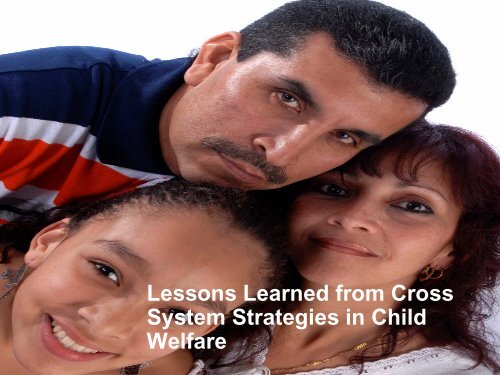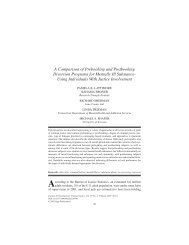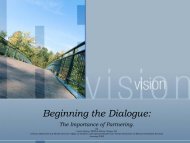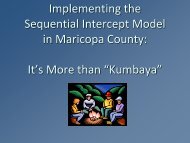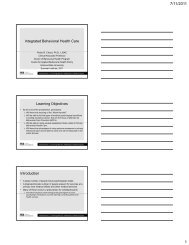Developing a Logical Framework and Plan for Conducting your ...
Developing a Logical Framework and Plan for Conducting your ...
Developing a Logical Framework and Plan for Conducting your ...
Create successful ePaper yourself
Turn your PDF publications into a flip-book with our unique Google optimized e-Paper software.
Lessons Learned from Cross<br />
System Strategies in Child<br />
Welfare
Lessons Learned from Cross System<br />
Strategies in Child Welfare<br />
Panelists:<br />
•Nancy Hansen, MSW, DES/DCYF<br />
•Carmen<br />
Preciado, , LCSW, DES/DCYF<br />
•Ron<br />
Carpio, , MSW, TERROS<br />
•Jack Robinson MA, LPC, LISAC , TERROS<br />
•Tracy Stevens, M.A., Westcare Arizona<br />
•Jesus Gonzales , insert, SEABHS<br />
•Grace Diaz, B.A., AzPac
An Overview<br />
of the<br />
AFF Program
Why Did We Start This Work?<br />
Families, Child Welfare, TANF<br />
& Substance Abuse<br />
• Over 10 years, fueled by substance<br />
abuse, the number of abused <strong>and</strong><br />
neglected children has doubled:<br />
– 1986 – 1.4 million<br />
– 1997 – more than 3 million<br />
– Eight times greater than the increase in the<br />
children’s s population<br />
• * ”No Safe Haven”,Center on Addiction & Substance Abuse at Columbia University
Adoptions <strong>and</strong> Safe Families<br />
Act (ASFA)<br />
• ASFA was passed into law by Congress in 1997.<br />
• Congress was concerned over the length of time children<br />
were living in foster care<br />
• ASFA requires that the courts begin the process to<br />
terminate the parental rights of parents who have had<br />
children in foster care <strong>for</strong> 15 months out of the last 22<br />
months.<br />
• If a parent is in treatment <strong>for</strong> alcohol or drug abuse, they<br />
might not lose their parental rights if they stay in treatment,<br />
attend all court dates <strong>and</strong> show a desire/capcity<br />
to be<br />
reunited with their children.
Arizona Senate Bill<br />
1280<br />
• Innovative legislation - SB 1280 created<br />
AZ. Families F.I.R.S.T. (Families in<br />
Recovery Succeeding Together)<br />
• A Steering Committee chaired by the<br />
Governor’s s Office, with representation from<br />
the Legislature, the Judiciary <strong>and</strong> Child<br />
Advocacy guided ADES & ADHS in the<br />
development <strong>and</strong> implementation<br />
• Outcome Driven
What would it take<br />
to do this work?<br />
• Partnership between Arizona Departments of<br />
Economic Security <strong>and</strong> Health Services<br />
• Underst<strong>and</strong>ing systemic issues in Child<br />
Welfare, Employment, Substance Abuse &<br />
the Courts<br />
• Statewide change of substance abuse<br />
treatment <strong>for</strong> families in Child Welfare <strong>and</strong><br />
TANF towards Family Centered Practice
Legislative Outcomes<br />
Increase <strong>and</strong> improve the:<br />
• Availability<br />
• Timeliness<br />
• Accessibility<br />
of Substance Abuse Treatment
Per<strong>for</strong>mance Measures<br />
Reduction in:<br />
• Recurrence of child abuse <strong>and</strong> neglect<br />
• Substance abuse<br />
• # of days in foster care<br />
Increase in:<br />
• Obtaining or maintaining employment<br />
• # of children - permanency
Program<br />
Entry<br />
TANF<br />
CPS<br />
Report<br />
Arizona Families F.I .R.S.T. - SB 1280 Model<br />
Jobs<br />
CPS<br />
Pre-<br />
Screening<br />
Referral<br />
Case<br />
Management<br />
in DES<br />
Jobs<br />
Case<br />
Manager<br />
CPS<br />
Case<br />
Manager<br />
Screening, Service &<br />
Funding Coordination<br />
Outreach,<br />
Engagement<br />
& Screening<br />
Assessment<br />
Collaborative Partners<br />
Supportive Services<br />
• Child Care<br />
• Transportation<br />
• Housing<br />
Substance<br />
Abuse<br />
Education<br />
Out-Patient<br />
Intensive<br />
Out-Patient<br />
Residential<br />
Treatment<br />
Aftercare<br />
Within 24 hours Within 5 working Days<br />
Referral Screening Assessment<br />
Essential Elements<br />
• Outreach & Engagement<br />
•Motivat ional Interviewing & Ret ent ion<br />
•Relapse Ma na gement<br />
•Services <strong>for</strong> Children (Therapeutic Family Involvement)<br />
•Peer Support, Mentoring or Recovery Coaches<br />
•Gender-Specific Treatment<br />
•Family Focused & Child Centered<br />
• Culturally Responsive & Community Specif ic<br />
Referral to First Therapeutic Service - 14 days
Essential Elements<br />
• Outreach & Engagement<br />
• Motivational Interviewing & Retention<br />
• Relapse Prevention & Management<br />
• Gender-Specific Treatment<br />
• Family Focused & Child Centered<br />
• Culturally Responsive<br />
• Community Specific
Treatment Interventions<br />
• Outreach Engagement/Re<br />
Re-engagement.<br />
• Comprehensive Assessment.<br />
• Outpatient Substance Abuse Treatment.<br />
• Residential Treatment.<br />
• Case Management Services.<br />
• Supportive Services.<br />
• Aftercare Services.
Community Specific Best Practice<br />
Strategies<br />
• TERROS – Co Location<br />
• Westcare – Sober Living Environments<br />
• SEABHS – Integrated Family Teams<br />
• AzPac – Drug Court
TERROS, Inc.<br />
Families F.I.R.S.T. Co-location<br />
Project<br />
Ron Carpio, , MSW<br />
Jack Robinson MA, LPC, LISAC
Project History<br />
• Idea was presented in 2000<br />
• Challenge to sell to both parties<br />
• Team had experienced an unsuccessful<br />
attempt<br />
• Challenged by “Urban Legends”
Urban Legends<br />
• Clients will not come <strong>for</strong> services<br />
• Clients will be intimidated by CPS workers<br />
• Clients will not see treatment providers as<br />
separate from CPS<br />
• CPS will interrupt <strong>and</strong> distract clients<br />
• FF team building will be compromised.<br />
• Reduces staff’s s availability to provide client<br />
services<br />
• Client confidentiality will be compromised
Implementation Process<br />
• Established a co-location workgroup<br />
• Workgroup met monthly<br />
• Established pilot site<br />
• Worked out the “bugs”<br />
• Established next site<br />
• Developed co-location process
Project Overview<br />
• TERROS staff is co-located at 9 CPS sites<br />
• Provide SA expertise at TDM meetings<br />
• Improve coordination <strong>and</strong> communication<br />
• Forum to educate CPS staff on addiction <strong>and</strong><br />
addiction treatment.<br />
• Forum to educate FF staff on CPS responsibilities<br />
<strong>and</strong> philosophy.<br />
• Increase opportunities to engage families at the<br />
CPS offices
Families F.I.R.S.T. Co-Location<br />
Sites<br />
• DCYF District Office<br />
• 4000 North Central<br />
Ave<br />
• Glendale<br />
• Thunderbird<br />
• Gilbert<br />
• Avondale<br />
• Tempe<br />
• South Mountain<br />
• Talavi
SOBER HOUSING<br />
WestCare Arizona<br />
Tracy Stevens, M.A.<br />
Area Director<br />
Westcare Arizona
RURAL AREA<br />
• The sober living houses are located in<br />
Bullhead City, Arizona.<br />
• We are a desert area with extremely<br />
high temperatures.<br />
• We provide services to clients in<br />
Mohave <strong>and</strong> La Paz Counties which is<br />
approximately a 500 square mile area.
WHY IS IT A PROGRAM NEED<br />
• There are no Substance Abuse Residential<br />
facilities <strong>for</strong> people seeking treatment in Mohave<br />
or La Paz Counties.<br />
• Our 12 step community is very small.<br />
• There are a limited number of outpatient<br />
substance abuse treatment providers in either<br />
County.<br />
• Most clients in this area are on AHCCCS <strong>and</strong><br />
there is only one AHCCCS provider throughout<br />
Mohave County <strong>and</strong> only a couple in La Paz<br />
County.
HOW IT WORKS<br />
• Blossom House is a 90 day to 6 month program <strong>for</strong> women<br />
(children).<br />
• Emery House is 6 month program <strong>for</strong> men.<br />
• Highly structured <strong>and</strong> peer motivated.<br />
• Attendance at 12 step meetings daily.<br />
• Attendance at gender specific house meetings weekly.<br />
• Chores <strong>and</strong> curfews.<br />
• Resume <strong>and</strong> job search guidance.<br />
• Individual counseling available.<br />
• Substance abuse <strong>and</strong> domestic violence counseling<br />
provided at no cost.
HOW IT WORKS<br />
• R<strong>and</strong>om UA testing.<br />
• Bus tickets provided.<br />
• Vouchers <strong>for</strong> WestCare Thrift Store<br />
provided.<br />
• All household supplies, linens, dishes, etc…<br />
provided.<br />
• Staple foods provided.<br />
• Therapeutic environment.<br />
• Client’s s are required to seek <strong>and</strong> maintain<br />
employment.
BLOSSOM HOUSE
EMERY HOUSE
CHALLENGES<br />
• Clients often do not have the funds to<br />
pay <strong>for</strong> 1 st weeks rent.<br />
• Limited public transportation system.<br />
• Client’s s have minimal education.<br />
• Client’s s have very little prior work<br />
experience.<br />
• Due to criminal history, most client’s<br />
can only obtain employment at fast<br />
food restaurants.
CHALLENGES<br />
• The areas largest employers are the<br />
casinos. Many any client’s s are on<br />
probation <strong>and</strong> this makes getting<br />
fingerprint clearance almost<br />
impossible.<br />
• Since the houses are located in<br />
Bullhead City, most clients do not want<br />
to relocate to be in a sober<br />
environment.
SUCCESSES<br />
• Blossom House served 51 clients in<br />
2006. Approximately 35% (17) are still<br />
sober today.<br />
• Emery House served 65 clients in<br />
2006. Approximately 25% (16) are still<br />
sober today.<br />
• 8 women gave birth during their stay at<br />
Blossom House to Substance Free<br />
babies.
SUCCESSES<br />
• 75% of women were employed at the time of<br />
completion/discharge from Blossom House.<br />
• 85% of men were employed at the time of<br />
completion/discharge from Emery House.<br />
• United Way has provided scholarship money to<br />
help clients pay <strong>for</strong> first weeks rent.<br />
• Developed excellent relationships with community<br />
collaborators due to the success at both Emery<br />
<strong>and</strong> Blossom House.
SEABHS<br />
Integrated<br />
Family Team Process<br />
Jesus Gonzales<br />
“Integrating Child <strong>and</strong> Adult services”<br />
Revised 6/30/07
Integration of Child <strong>and</strong> Adult Services<br />
Through integration of the AZ Vision <strong>and</strong> 12<br />
Principles <strong>and</strong> the Principles of Person<br />
Centered <strong>Plan</strong>ning, SEABHS developed an<br />
integrated approach to serving families<br />
where the process is the same <strong>for</strong> everyone<br />
regardless of age, referral source, or focus<br />
of treatment.
Complex Needs Families<br />
Many of the families served by SEABHS have<br />
both parents <strong>and</strong> children enrolled in behavioral<br />
health services.<br />
These are often complex needs families with<br />
involvement in multiple state agencies including<br />
Child Protective Services (CPS), Adult or<br />
Juvenile Probation, Department of Corrections,<br />
etc.<br />
Traditional approaches to treatment have been<br />
unsuccessful <strong>for</strong> these families.
MCAS - Pregnant <strong>and</strong> post-partum partum substance<br />
abusing women. Services will be <strong>for</strong> the<br />
mother <strong>and</strong> the at risk child(ren).<br />
Arizona Families FIRST - Families involved in<br />
CPS as a result of substance abuse issues.<br />
Both MCAS <strong>and</strong> AFF populations are complex<br />
needs families <strong>and</strong> include referrals through<br />
the Arizona Families First program.
Coordination: Enrolled Parent <strong>and</strong> Child<br />
• Integrated services <strong>for</strong> the family<br />
• Single Family Team, including common members<br />
<strong>and</strong> client-specific members<br />
• Individualized service plan with<br />
common family objectives as well<br />
as individualized objectives<br />
• Common FT meeting with separate<br />
individual meetings as needed
SEABHS<br />
SUCCESS<br />
STORY
CHALLENGES
Drug Court<br />
Grace Diaz, B.A.<br />
AzFF Program Coordinator<br />
Catholic Charities
Overview of Family Drug Court<br />
• History: Drug<br />
Court began in<br />
February 1999 in<br />
Prescott<br />
• Purpose<br />
• Participants<br />
• Requirements
AFF Involvement<br />
• Collaboration with FDC started in Jan 2001<br />
• All FDC clients since 2001, have been AFF<br />
clients<br />
• Numbers: 166 as of 12/2006.<br />
• Facilitation of treatment services<br />
• Re-engagement<br />
engagement
Participation in the drug court<br />
staffing<br />
• Comprehensive update to<br />
the Judge<br />
• Drug screening results<br />
• Participation in treatment<br />
• Client’s s progress across<br />
multiple services<br />
• Problem solve with other<br />
team members around<br />
specific issues
Provision of supportive services<br />
• Facilitating acceptance into a halfway house<br />
• Transportation assistance to treatment related<br />
services.<br />
• Assisting with purchase of drug screening<br />
• Gender specific family counseling<br />
• Aftercare services to benefit reunification
Benefits to Clients<br />
Incentives<br />
• Praise from the judge<br />
• One on one dialogue with the Judge at each Court visit<br />
• Positive rein<strong>for</strong>cement<br />
• Reduction of community service time<br />
• Progression through the phases<br />
• Decrease in drug screen<br />
• Decrease in court appearances<br />
• Feeling of success<br />
Graduation rate 42%
Consequences/Sanctions<br />
• Warning from the Judge<br />
• Increase in 12-Step meetings<br />
• Additional community Service hour<br />
• Jail time<br />
• Increase in drug screens<br />
• Increase in Court appearance<br />
• Return to previous phase<br />
• Change in probation status<br />
• Termination from program <strong>and</strong> incarceration<br />
• Filing of a petition to sever parental rights
Upon successful completion <strong>and</strong> graduation<br />
participants may at that time benefit from:<br />
• Family reunification<br />
• Completion of drug treatment<br />
• Dismissal of charges<br />
• Honorable discharge from probation<br />
• Employment<br />
• Clean <strong>and</strong> sober lifestyle<br />
• Development of pro-social network
Outcomes<br />
• Drug Free babies<br />
born since<br />
inception of<br />
program<br />
• Children reunified<br />
• Development of<br />
healthy, sober,<br />
friendships<br />
• Creation of support<br />
systems.
Best practice<br />
approaches<br />
contribute to<br />
positive<br />
outcomes <strong>for</strong><br />
children <strong>and</strong><br />
families!
New AFF Referrals<br />
n = 4,727<br />
SFY 2006<br />
Referral Outreach<br />
n = 4665<br />
97% of new referrals<br />
Individuals Accepting Services<br />
n = 4,272<br />
90% of new referrals<br />
Individuals Assessed<br />
n =3,171<br />
67% of new referrals<br />
New AFF Clients<br />
n = 2,902<br />
72% of total AFF clients<br />
Coninuing AFF Clients<br />
n = 1,112<br />
28% of total AFF clients<br />
Total AFF Clients<br />
n = 4,014
Timeliness, Availability, <strong>and</strong><br />
Accessibility of Services<br />
• More than 16,400 individuals referred<br />
to the program in five years<br />
• Over 90% were contacted through<br />
outreach <strong>and</strong> engagement in five<br />
years<br />
• Rapid contact within a day or two<br />
• Nearly 70% received a substance<br />
abuse assessment<br />
• Coordinated <strong>and</strong> comprehensive<br />
array of services
Alcohol <strong>and</strong> Drug Problems<br />
(2006)<br />
• Over 50% of AFF clients reported using<br />
alcohol or illegal substances in the 30<br />
days prior to assessment<br />
• Most common substances used:<br />
– Methamphetamines – 29%<br />
– Alcohol – 26%<br />
– Marijuana – 24%<br />
– Cocaine/crack – 8%<br />
• Polysubstance use – 62%
• Over 60% of client program closures (n =<br />
1605) demonstrated no drug use at all<br />
during their participation in the program,<br />
as verified by drug screenings.
Child Safety <strong>and</strong> Reduction<br />
of Child Abuse <strong>and</strong> Neglect<br />
• Children of AFF caregivers experienced less<br />
subsequent neglect <strong>and</strong> abuse compared to<br />
state averages.<br />
– Out of 4,014 AFF clients, only 2% received a<br />
“substantiated” report finding based on one or<br />
more allegations filed subsequent to their<br />
enrollment in the AFF program.<br />
– Overall rate reported nationally <strong>for</strong> an 11-month<br />
period was 8% (Fluke et al, 2005).
Permanency <strong>for</strong> Children<br />
Through Reunification<br />
• Children of AFF caregivers achieved<br />
permanency at rates that exceeded<br />
the state average.<br />
– Over 900 children of AFF<br />
caregivers achieved permanency<br />
this year.<br />
– 68% of AFF children reunified.<br />
– 51% overall reunification rate<br />
reported by CPS <strong>for</strong> the period<br />
ending March 31, 2005.
In Summary<br />
• During the course state fiscal year 2006,<br />
4,014 individuals reported to Child Protective<br />
Services <strong>for</strong> neglect or abuse of their<br />
children, <strong>and</strong> known to have ongoing issues<br />
related to the use of alcohol <strong>and</strong> drugs, have<br />
been served by this innovative program.
• In 2006, more than 650 children have been<br />
returned to the custody of their parents without<br />
a recurrence of suspected neglect or abuse.<br />
• Parents have experienced success in<br />
addressing their substance use problems.<br />
• More than 60% of clients who completed their<br />
participation in AFF services demonstrated no<br />
drug use at all during their participation in the<br />
program, as verified by drug tests.
• Families have been able to access a<br />
seamless network of treatment services <strong>and</strong><br />
supports designed to promote ongoing<br />
recovery <strong>and</strong> family stability.
Conclusions<br />
Special design of this program facilitates:<br />
• Engagement of a hard to reach population<br />
• Bridging systems to enhance client outcomes<br />
• Integrating best practices to meet community<br />
need
Questions<br />
<strong>and</strong><br />
Answers
For More In<strong>for</strong>mation<br />
• Aimee Amado –<br />
DES/DCYF<br />
AAmado@azdes.gov<br />
• Carmen Preciado -<br />
DES/DCYF<br />
CPreciado@azdes.gov<br />
• Ron Carpio or<br />
Jack Robinson - TERROS<br />
Ronc@terros.org<br />
jackr@terros.org
For More In<strong>for</strong>mation<br />
• Kristi Johnson – Westcare Arizona<br />
kristi.johnson@westcare.com<br />
• Grace Diaz – AzPac/ / Catholic<br />
Charities<br />
GDiaz@cc-az.org<br />
az.org<br />
• Jesus Gonzales or Dan Barden –<br />
SEABHS<br />
JesusGonzales@seabhssolutions.org<br />
Dbarden@seabhssolutions.org


